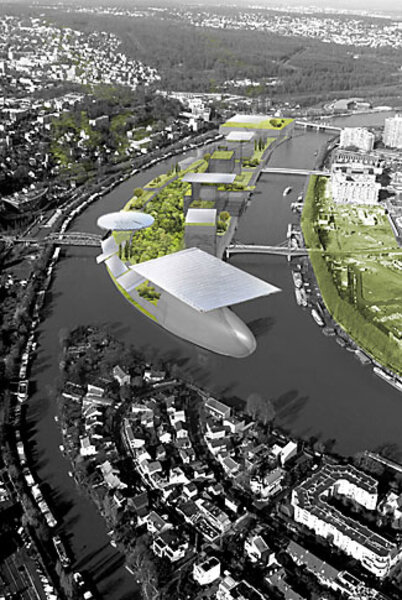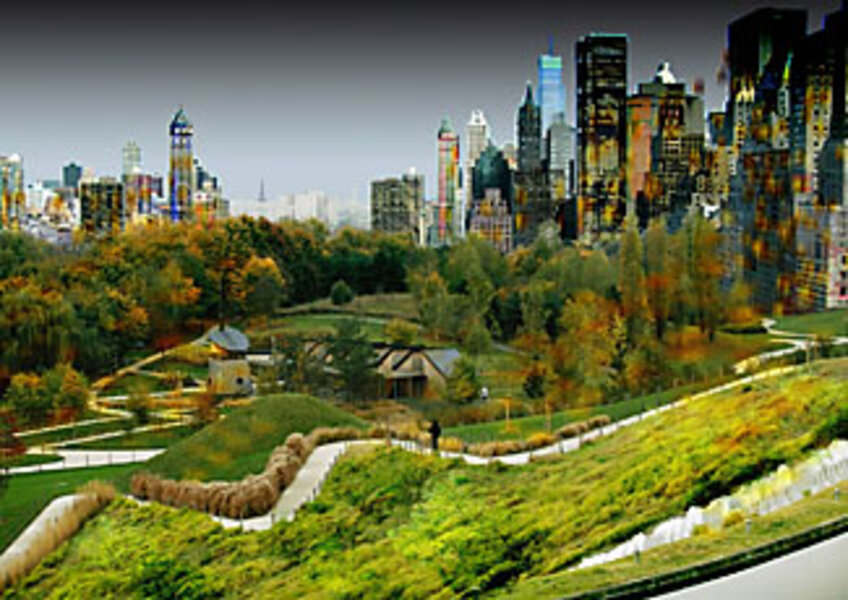Sarkozy's daring design dreams for a new 'Grand Paris'
Loading...
| Paris
Kings, emperors, generals, and presidents have all tinkered with the city.
It's been walled, razed, and excavated. In the zeal of modernization that seized planners in the 1970s, its skyline was pierced by a single 59-story skyscraper and its boundaries fixed in concrete by an eight-lane beltway.
Paris is once again on the drawing board. Commanded by President Nicolas Sarkozy to reimagine the capital as a "world class city," teams of internationally known architects have come up with 10 strategies for creating a metropolitan area known as Grand Paris – it's the first major redesign since the Napoleonic era.
Their ideas range from the prosaic to the fanciful. But they all say that Paris – its public transit system saturated, its periphery spoiled by ugly housing projects, and its suburbs an undefined sprawl of disconnected towns – does not work.
"It's slowly losing its vitality," says award-winning Paris architect Jean Nouvel. "What we laughingly call regional development is finished. If we want to maintain the prestige of Paris, we have to look after it."
The government hired the design teams after a competition last spring – a more optimistic time before the economic outlook in France started looking so grim. Even so, it was never entirely clear what would become of their proposals.
The political complications are formidable, given that the Paris region is made up some 400 separate local governments. A slew of master plans for urban development, big and small, already exist. And the last time anyone managed to redraw Paris on a grand scale was in the 1850s, when Emperor Louis Napoleon replaced its warren of slums with grand boulevards and perfectly aligned stone buildings.
But the opportunity to weigh in the future of an iconic city proved irresistible.
"It is fun – very expensive fun," says Richard Rogers, the British architect who also advises London and Barcelona on their blueprints for the future. "It's a fantastic thing that the French are doing."
The architectural teams, six of them French, were given the mission of envisioning the "post-Kyoto" metropolis. They were left to define the boundaries of this newly conceived Grand Paris as they saw fit, but it was to incorporate the best of sustainable design techniques, energy efficient structures, and a mix of housing for both rich and poor.
President Sarkozy is expected to give a hint of what he might do with all the plans when they go on public view at the national architecture museum next month. Summaries of the designs were presented last week, though, and the common themes are already clear.
All of the architects rejected the 1960s French solution to suburban sprawl of creating discrete new satellite cities. Instead, most proposed filling in the unused spaces of the metropolitan area – derelict land, underused public buildings, weed-filled tracts along railways and rooftops – to preserve the countryside and make the metropolis more compact.
"I don't know any other big city where the heart is so disconnected from periphery," says Mr. Rogers. "The city is cut in pieces." His team suggested starting by building parks alongside five disused suburban rail lines – an investment that he predicted would increase property values and generate economic development.
Most of the planners urged intense use of space within the limits of historic Paris. They talked of high-speed trams on top of the beltways, malls on top of subway stations, and gardens on the five square miles of rooftops in Paris. A new mixed-use neighborhood in the center of Paris could arise, they said, if only the neglected stretch of land between the Gare du Nord and Gare de l'Est train stations in central Paris were freed up for private development.
More lyrical suggestions came from Roland Castro, a Paris architect who once ran for president as the candidate of the Movement for a Practical Utopia. His team included a sociologist, a writer, and a philosopher. "We applied the philosopher's concept that in every man there is a poet, and the city in which he lives there should be mystery, secrets, and surprises."
Mr. Castro, known for his quixotic campaign in the 1990s to relocate government ministries to the suburbs, would like to smash the old Paris model of concentrating wealth and power in the center. His proposals for Grand Paris include a 250-acre central park surrounded by modern skyscrapers for La Corneuve, now a grim suburb of anonymous subsidized housing projects, and integrating river boats into the regional public transit system.
Paris architect Antoine Grumbach said every world-class metropolis, from London to Beijing, has an opening to the sea. His team proposed a Grand Paris stretching westward along the Seine River valley to the port of Le Havre, a linear but coherent whole that encompasses the stretches of factories, universities, farmland, and cities that already hug the river.
One in 6 people in France live in the Île-de-France, the administrative region that now includes the municipality of Paris. Mr. Grumbach likes to describe it as the design equivalent of a fried egg, with the suburbs sprawling in an unbounded mess from the compact yolk of the historic capital. [Editor's note: We got the ratio wrong on the proportion of the French population in Paris.]
Commuter rail lines and roads radiate from the center. People may live in one suburb and work in another, but they all have to change trains in a jam packed station in central Paris. So, no grand urban plan will really carry the region into the future, the designers all said, unless it brings the heavily populated working-class suburbs out of their economic and geographic isolation.
"The riots brought the metropolitan crisis to even the people of Paris," said Christian de Portzamparc, another Paris architect, referring to the 2005 and 2007 unrest that started in the suburbs and spread to major cities. "There are places where the public authorities should step in, where value would be generated immediately," he added. "If you're going to take an all-out approach, you'll get results in 200 years."






